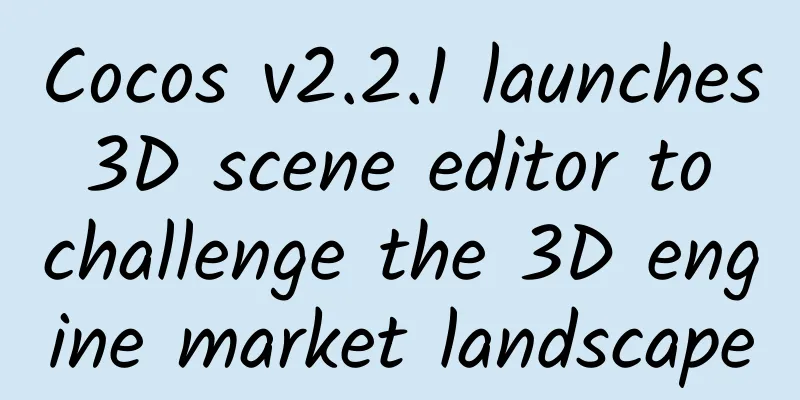Cocos v2.2.1 launches 3D scene editor to challenge the 3D engine market landscape

|
On March 30, the highly anticipated cocos v2.2.1 was released and updated. The new cocos v2.2.1 made some corrections and a lot of optimizations based on the original cocos engine, and added new features such as animation playback speed settings, cocos resources and extension stores, which attracted great attention from developers. What attracted developers' attention even more was the 3D scene editor launched in cocos v2.2.1. Heavy-duty games have become an industry consensus, and 3D mobile games may become a new growth point in the market As early as the beginning of 2014, according to data from relevant research institutions, the proportion of real-time mobile games in the Chinese mobile game market has reached 44%, card games have reached 26%, turn-based games have reached 17%, and strategy and other types of games have only 7% and 6% respectively. Heavy games represented by real-time and turn-based games became the focus in February 2014, and the two types of games together accounted for 61% of the revenue. More importantly, from the perspective of market performance, heavy mobile games have obvious advantages over light online games and stand-alone mobile games in terms of overall user activity, appeal to senior players, and revenue scale. It was also after this that heavy games became a keyword repeatedly mentioned in the industry, and it continues to this day. As the most important type of heavy mobile game development, 3D games have unsurprisingly become the focus of major developers, publishers, and even channels. The popularity of hardcore mobile games has been on the rise since Q4 2014. With the help of developers and publishers, a considerable number of 3D mobile games have been launched in the domestic market, and their performance is quite good. It is in this environment that 3D engine technology, especially the global mainstream Cocos engine and Unity engine, has received more and more attention from the mobile game industry. As one of the most widely used mainstream mobile game engines in the world, the cocos engine occupies an absolute leading position in the Chinese market, and its 2D engine technology has a market share of more than 70%. However, the cocos engine, which entered the field of 3D engine development technology two years ago, has launched a 3D scene editor today after completing the support of the underlying framework for 3D functions, becoming the focus of the mobile game industry in recent times and attracting great attention from practitioners. Cocos launches 3D scene editing function, making 3D mobile game development faster The newly released cocos v2.2.1 version has three highlights: first, it provides a 3D editor; second, it provides a complete tool chain that can complete the entire process of building, developing, debugging, and publishing; third, it provides open Cocos Store extensions and resource stores to access various services. Among them, the 3D scene editor, which is highly anticipated by developers, provides three major functions in the first version: scene and character model support, particle effects, and camera, making the game production function more powerful. This not only indicates the maturity of the 3D technology of the cocos engine, but also marks a new milestone in the development of the 3D technology of the cocos engine. Cocos 3D Editor Interface From the actual performance of the cocos 3D editor, the first is its 3D model import and setting support. The new cocos v2.2.1 version of the 3D editor supports the parallel development of multiple scenes. During the development process, the entire scene is implanted through the 3D model, and then the 3D character is imported, and the character can have its own animation. Secondly, the 3D particle function. The particle function implantation allows developers using the cocos engine to call the corresponding particle effects from the mature particle resource package at any time to add them to the game during the development of various effects such as environmental characteristics, skill special effects, character aura, etc., which is convenient enough compared to the current traditional development method. Finally, the camera function, that is, 3D Camera, can easily achieve the effect of multiple cameras and make cool battle close-ups. Thanks to this new 3D editor, developers can easily develop various 3D models, scenes, and character special effects using the cocos engine. Cocos engine 3D technology is gradually maturing, with outstanding performance and adaptability advantages The great success of "Fishing Master 3" has proved that Cocos' 3D technology can develop high-quality 3D mobile games. However, in the field of more serious 3D mobile games, the use of Cocos technology to develop "Hearthstone Three Kingdoms" has already allowed everyone to experience the performance advantages and maturity of Cocos in 3D technology. According to Zhu Wei, the project leader of "Hearthstone Three Kingdoms", the current development progress of "Hearthstone Three Kingdoms" has been completed by more than 80%. They have used many 3D technologies of the Cocos engine, and the indicators currently achieved by the product have also satisfied the development team. Screenshot of Hearthstone Three Kingdoms Cocos 3D Editor Interface The first is the performance issue. On older models like iPhone 4, the entire battle screen of Hearthstone Three Kingdoms can be kept stable at more than 24 frames, which is more advantageous than other products; the second is the package. Currently, the game has 50 heroes, including models, textures, special effects, game scenes, maps, and UI. The entire package is currently 100M, and after another round of optimization, it is expected to be controlled at around 80M, thanks to the c3b format carefully optimized by the cocos engine. The last is adaptability. This version was directly typed out in cocos and put on the third-party evaluation agency Testin. Without any optimization, it has achieved 90% adaptability, which mainly relies on the superior adaptability function of cocos itself. According to the introduction of cocos's Wang Zhe, the 3D particles, 3D animation, and 3D multi-camera functions of the cocos v2.2.1 editor are now mature and available. The next version is planned to provide skybox and terrain functions, and the next version will develop 3D navigation grids, 3D paths, 3D physics support, etc. By then, developers can use the cocos engine to quickly and efficiently develop complete 3D MMORPG games, and have smaller packages than traditional 3D games, higher adaptability, and better game graphics, combat, and special effects performance, and reuse all the historical experience and engine expansion of game developers on the cocos engine. Cocos v2.2.1 3D scene editing function challenges the 3D engine market pattern In fact, the 3D scene editing function is only the most noteworthy part of the new cocos v2.2.1 version. In the process of launching this new version, the many optimizations and changes of the cocos engine are also worthy of attention from industry players. First, after continuous optimization, the cocos engine has achieved 99.37% compatibility on Android phones, which is almost a record-breaking data, which is beyond the reach of other engines. This solves the biggest problem of compatibility and adaptation for developers who choose to develop 3D games. Secondly, the cocos engine is constantly optimizing the size of the package. At present, the cocos engine uses platform interface encapsulation technology to replace the libcurl network library model, which reduces the package size by nearly 30%, and the innovative c3b model compression format further solves the problem of 3D mobile game packages being too large. Last but not least, the free and open source cocos engine has launched a 3D scene editing function, which not only makes 3D game development more cost-effective and efficient, but also its rich plug-in material library, as well as Windows and Mac synchronous updates, also greatly facilitates team collaboration among developers. It can be said that after two years of continuous improvement, improvement, optimization and innovation, the maturity of Cocos engine 3D technology has brought developers a very complete one-stop 3D mobile game development solution. What is particularly interesting to practitioners is that at the mobile game conference in Chengdu two years ago, David Helgason, CEO of Unity, and Chen Haozhi, CEO of Touch Technology, appeared one after another. David Helgason released the 2D support of the Unity engine, and Chen Haozhi announced the 3D function of Cocos. The two engine giants entered each other's hinterland. From the PK of the two heroes for more than a year, the domestic mobile game development is still the long-standing mainstream technology selection of "2D with Cocos, 3D with Unity". The launch of the 3D editor by Cocos can be seen as a move to further challenge the market structure of 3D engines. The watershed of the future pattern of the two most watched mobile game engines in the world. So will the future pattern of mobile game engines be rebuilt like this challenging announcement? As mentioned above, the huge advantage of the cocos engine in the field of 2D mobile game development has forced Unity to start seeking the layout of the 2D market, but in order to impact the share of cocos in the 2D market, Unity has not achieved it in more than a year. However, with the maturity of the 3D technology of the cocos engine, its advantages in performance, adaptability and other aspects have greatly improved its competitiveness in the field of 3D engines. This may be a more eye-catching round of competition. But who will be the most uncomfortable? It may not be Unity or cocos, but other mobile game engines. But in any case, the ultimate beneficiaries are still the majority of mobile game developers. |
<<: Talking about Programmers Series: Oh, I am a ghost problem!
>>: Tools that make programmers lazy: Jenkins + Dandelion
Recommend
Pay attention to the following three points to help you transform from a programmer to an engineer
[[151076]] When I first started working, the inte...
How to write good copy? Learn these 17 methods!
1. First you need to digest the information about...
What are the requirements for adding keywords to Baidu’s bidding promotion?
What are the requirements for adding keywords to ...
Tik Tok search user ranking rules, what are the benefits of Tik Tok search?
Nowadays, most people use their free time to watc...
Classic APP case: How did Taobao Tmall App create the Double 11 traffic-generating banner with hundreds of millions of traffic?
Every year when the annual big promotion season c...
When will the 2020 epidemic end and when will the 2020 epidemic be lifted?
I want to go out, but when is it safe? Will the e...
iOS 13: More system apps and components written in Swift
Apple released the new Swift programming language...
The most practical interpretation of video material characteristics and distribution strategies!
Everyone is familiar with advertisements. There a...
Product Operation: How can products improve user stickiness?
Low-frequency, rigid-demand products have multipl...
Soul Competitive Product Analysis
In the stranger social industry, if a social appl...
What are the functions of the Guangzhou Insurance Mini Program? How much does it cost to develop a WeChat insurance mini program?
Not long ago, a colleague of mine bought another i...
Reviewing the operation of NetEase Yanxuan’s 411 anniversary event!
NetEase Yanxuan is different from platform-based ...
Xiao Chongyu Chongchong synchronous belt reel group
Xiao Chongyu Chongchong synchronous belt reel gro...
What should I do if I don’t dare to live broadcast short videos? What should I do if I want to live stream but don’t know how to put on makeup?
A big problem facing video creators is the issue ...
All the information flow advertising optimization tips you want are here!
Account optimization refers to the process of con...









